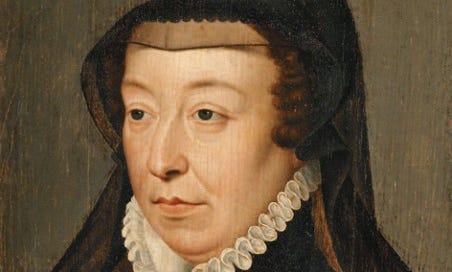Florence is one of my favourite cities. Why you ask? Is it Michaelangelo’s David? Or Donatello’s David? How about the Uffizi museum with paintings like The Birth of Venus or Le Primavera? How about Brunellschi’s Dome? The incredible leatherwork?
Those are all nice, and worth seeing, but why Florence is my favourite city can be summed up in one word.
Gelato.
Florence lays claim to being the originator of gelato. When and by whom are in some dispute, however.
Gelato is different from ice cream in that Gelato is softer, uses more milk and less cream and doesn’t usually use egg yolks.
Probably working from a recipe for sorbet that Marco Polo brought back from China in 1295, Cosimo Ruggeri created the first gelato fior di latte (milk cream) in Catherine de’ Medici’s court and she subsequently took it to France in the 1530s.
Rabbit Hole:
Catherine de’ Medici was Queen of France from 1547 to 1559 as the wife of Henry II. She was the mother of Francis II, Charles IX and Henry III. She was married to Henry II in 1533, at the age of 14 in a marriage arranged by Pope Clement VII. I assume Fior di Latte was part of the dowry.
Okay, so follow along, use notes if you have too. Clement the VII was born Giullio de’ Medici. His uncle was Lorenzo de’ Medici, better known as Lorenzo the Magnificent which made Giullio cousin to Giovanni de’ Medici (later Pope Leo X).
Lorenzo the Magnificent was the Lord of Florence from 1469 - 1492. Lorenzo was the patron of Botticelli, da Vinci, and Michelangelo to name just three. His predecessor was Piero de’ Medici, known to history as Piero the Gouty and isn’t that a nickname you want to be stuck with for eternity. When Lorenzo died at age 43 he was succeeded by his second son, also named Piero, known to history as Piero the Unfortunate. Piero the Unfortunate had one son (Lorenzo) and three daughters – that wasn’t why he was called the unfortunate. Piero ruled Florence for two years and did such a horrible job that he and his family had to flee the city. A de’ Medici would not rule again until 1512 when Giovanni took the city by siege. The next year Giovanni was elected Pope Leo X and Piero the Unfortunate was bypassed in favour of his son, Lorenzo II, who became the new ruler of Florence. Lorenzo the II had a daughter, Catherine.
I had no reason to include all that information in a story about gelato except I really wanted to find a way to include Lorenzo the Magnificent, Piero the Gouty and Piero the Unfortunate into a blog. It sounds a like family of magicians who get worse each generation.
Thus endth the rabbit hole.
Catherine de’ Medici was known as the ultimate political operative. She had eighty (80) ladies in waiting. Catherine invested in magnificent court festivals where her ladies in waiting, known as the “Flying Squadron”, would use their charms to seduce information out of rivals and allies. Catherine was reputed to know more about every member of every European royal house then most of the house members themselves. In a way she reminds me of J. Edgar Hoover. Both had lots of information on opponents and allies that could be used to control, and both wore dresses.
(None of this is really surprising since it was the Medicis and their political maneuvering who inspired Machiavelli to write “The Prince” in 1513. Catherine was really just living up to the family brand.)
Right, back to Gelato.
Gelato, that is just a fun word to say.
Gelato as we would recognize it appeared in 1565 when a Florentine, Bernardo Buontalenti created “gelato alla crema”, which was brought to Paris in 1686 when Franceso Procopio dei Coltelli brought his grandfather’s gelato making machine to Paris and opened Café Procope. Louis XIV so loved gelato he made Procopio a French citizen and gave him a royal licence to be the sole manufacturer of gelato for all of France. I’m guessing after this Procopio didn’t charge Louis XIV extra for sprinkles or chocolate topping.
So yes, Florence has magnificent art and sculpture and architecture and it’s a great city to walk around the downtown core and it has some great culinary dishes and wonderful leather work, which I’ve written about in a previous blog, but the real reason you should go to Florence is for the gelato.
So how to tell good gelato from bad? Well, the easiest way is the colour. High quality gelato is made with natural ingredients so the colours tend to be less vibrant. Shiny gelato either has too much sugar or it is old. Generally, smaller selections mean they gelateria is using only what is in season, so that’s a good sign, although many gelaterias have fake flavours like Kinder, or Cookies and Cream along with natural gelatos.
Above is an example of some good gelato, generally dull in colour, - the brown one on the left edge is pistachio, which should be a brown colour, not a vibrant green.
So, go now, find a gelateria, eat, enjoy.
Remember, food is love (or something like that.)
To read about Catherine de Medici: Rival Queens (about Catherine and her daughter); Blood, fire and Gold (about Catherine and Elizabeth I); The Serpent Queen.






